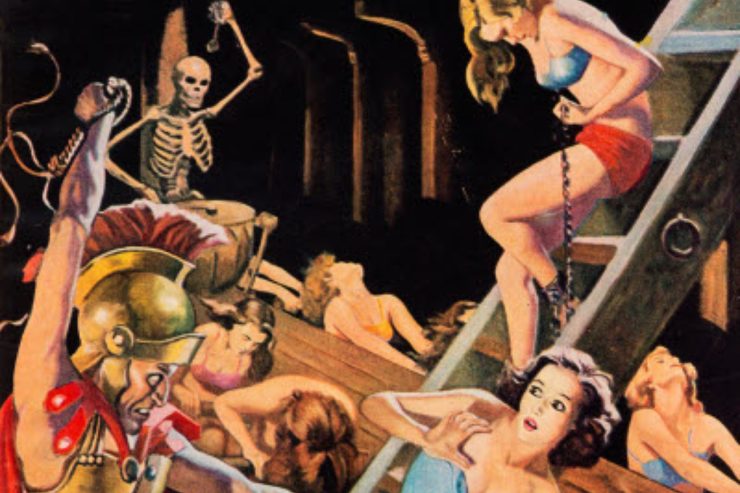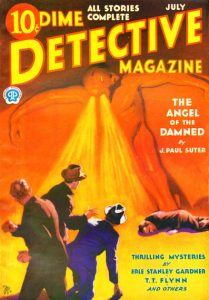 In addition to celebrating “A Half-Century of Pulp Cons,” the centennial of Fiction House, and the 125th anniversary of the birth of Western artist Nicholas Eggenhofer, PulpFest 50 will also salute the ninetieth anniversary of Popular Publications’ “Dime” line of pulp magazines.
In addition to celebrating “A Half-Century of Pulp Cons,” the centennial of Fiction House, and the 125th anniversary of the birth of Western artist Nicholas Eggenhofer, PulpFest 50 will also salute the ninetieth anniversary of Popular Publications’ “Dime” line of pulp magazines.
Popular Publications was founded in the fall of 1929 by Henry “Harry” Steeger and Harold Sanford Goldsmith. A year later, the new publishers launched their first four pulp magazines — Battle Aces, Detective Action Stories, Gang World, and Western Rangers. Unfortunately, all but Battle Aces lost money for the new company.
Earning just enough money to stay afloat, Steeger and Goldsmith decided to debut two new titles in the fall of 1931. Both dated November 1931, they were the short-lived Underworld Romances and Dime Detective. Costing one thin dime, the latter was an instant hit.
With America in the throes of The Great Depression, Dime Detective became the cornerstone for a line-up of similarly titled and priced magazines. The first of these debuted with their December 1932 issues — Dime Western Magazine and Dime Mystery Book Magazine.
Perhaps modeled after Fiction House’s Detective Book Magazine, Popular’s Dime Mystery Book Magazine featured “A New $2.00 Detective Novel.” Some were reprinted from the book trade, while others were originals. Each issue also included an Edgar Wallace reprint, a small number of short stories, and a puzzle.
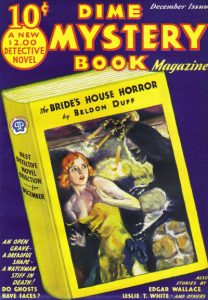 Unfortunately, most of the $2 novels were slow-moving, while the look of the magazine — featuring a picture of a book on each cover — was rather dull. The magazine failed to sell.
Unfortunately, most of the $2 novels were slow-moving, while the look of the magazine — featuring a picture of a book on each cover — was rather dull. The magazine failed to sell.
Rather than abandoning Dime Mystery Book, Harry Steeger decided to try something different. Inspired by the Grand Guignol Theater of Paris, Steeger created a new genre of pulp fiction — the weird-menace story.
With its October 1933 issue, Dime Mystery Magazine lost the “Book” from both its title and cover art. Its slow-moving “two-dollar novel” was chopped in half with the rest of the pulp filled with a few novelettes and several short stories. The cover art was turned over to the “King of the Pulp Artists,” Walter M. Baumhofer. Inside its covers, the Popular pulp featured authors such as Wyatt Blassingame, Hugh B. Cave, Frederick C. Davis, John H. Knox, and Norvell Wooten Page, author of the first weird menace novella, “Dance of the Skeletons.” It was the lead story of that October 1933 number.
In “Pulp Horrors of the Dirty Thirties,” writer, anthologist, and 1990 Lamont Award winner Don Hutchison writes:
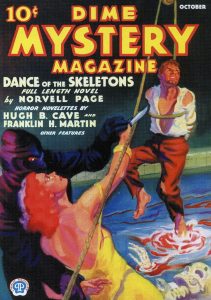 The so-called “shudder” or “weird-menace” titles were a blood-red splash of color in the grey days of the Great Depression. . . . In their nightmare universe, it was always a dark and stormy night. Tethered damsels suffered in the clutches of fiends such as hell-mad surgeons, warped scientists, and masked and cowled cultists, eagerly abetted by legions of demented dwarfs and horny hunchbacks. They stripped, whipped, and boiled their curvaceous victims with the enthusiasm of medieval inquisitors. Even the requisite rock-jawed heroes of these stories suffered a purgatory of horrors in order to rescue their brutally treated fair maidens.
The so-called “shudder” or “weird-menace” titles were a blood-red splash of color in the grey days of the Great Depression. . . . In their nightmare universe, it was always a dark and stormy night. Tethered damsels suffered in the clutches of fiends such as hell-mad surgeons, warped scientists, and masked and cowled cultists, eagerly abetted by legions of demented dwarfs and horny hunchbacks. They stripped, whipped, and boiled their curvaceous victims with the enthusiasm of medieval inquisitors. Even the requisite rock-jawed heroes of these stories suffered a purgatory of horrors in order to rescue their brutally treated fair maidens.
The retooled Dime Mystery Magazine was another instant hit. Steeger and Goldsmith soon introduced two companion magazines, Terror Tales and Horror Stories. Before long, other publishers released their own shudder pulps: Ace Mystery, Eerie Mysteries, Eerie Stories, Mystery Novels and Short Stories, Mystery Tales, Spicy Mystery Stories, Thrilling Mystery, Uncanny Tales, and others.
As the field grew, so did the depravity. Gothicism gave way to sadomasochism as writers were told to “go for the throat.” Dime Mystery even added defective detectives to the mix — private eyes with hemophilia or paraplegics or suffering from poor eyesight or deafness.
As the terrors and horrors mounted, so did the backlash. Reform groups such as the National Organization for Decency in Literature began to pressure news dealers to stop selling magazines they found objectionable. The United States Post Office Department was likewise asked to deny second-class mailing rates to publishers of indecent magazines. Big city mayors threatened newsdealers with the loss of their licenses if they continued to sell objectionable magazines.
With their point-of-purchase sales and mailing privileges threatened, publishers retrenched. In 1941, Popular shut down both Horror Stories and Terror Tales, while Dime Mystery Magazine was retooled once again. A May 1941 editorial announced, “Not until this issue have we been able to give you a full 100 percent sample of the magazine we always knew Dime Mystery could become.”
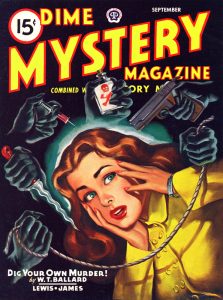 Now a bi-monthly, Dime Mystery was transformed into a fairly pedestrian mystery and detective magazine. While some yarns continued to feature a hint of the supernatural or a strange villain, gone were the truly shuddersome stories of the middle thirties. With its November 1944 number, the pulp was combined with 10 Story Mystery Magazine, a relatively short-lived title published by Popular’s cut-rate subsidiary, Fictioneers, Inc. Dime Mystery soldiered on until 1950 when it became 15 Mystery Stories. Afterward, it lasted for five more issues.
Now a bi-monthly, Dime Mystery was transformed into a fairly pedestrian mystery and detective magazine. While some yarns continued to feature a hint of the supernatural or a strange villain, gone were the truly shuddersome stories of the middle thirties. With its November 1944 number, the pulp was combined with 10 Story Mystery Magazine, a relatively short-lived title published by Popular’s cut-rate subsidiary, Fictioneers, Inc. Dime Mystery soldiered on until 1950 when it became 15 Mystery Stories. Afterward, it lasted for five more issues.
Under its various names, Dime Mystery Magazine ran for a total of 159 issues, lasting for nearly eighteen years.
We hope you’ll join PulpFest 50 as we celebrate the nineteenth anniversary of Popular Publications’ Dime Mystery Magazine. Beginning at 8:50 PM on Thursday, August 4, 2022, award-winning popular culture historians Ed Hulse and Garyn G. Roberts will discuss the “chameleon” of Henry Steeger’s and Harold Goldsmith’s strong line of pulp magazines.
A journalist and pop culture historian, Ed Hulse covered the home video and motion picture industries for more than 30 years. Since 2002, he has edited and published the award-winning, pop culture journal Blood ‘n’ Thunder. The winner of the Lamont Award in 2007, Ed is a prolific public speaker who has lectured on various aspects of vintage American popular culture for museums, libraries, and universities. His books include The Art of Pulp Fiction, The Blood ‘n’ Thunder Guide to Pulp Fiction, Distressed Damsels and Masked Marauders, Handsome Heroes and Vicious Villains, The Wild West of Fiction and Film, and many other titles. In 2017, he co-edited The Art of the Pulps, with Doug Ellis and the late Robert Weinberg. Ed’s website can be found at muraniapress.com.
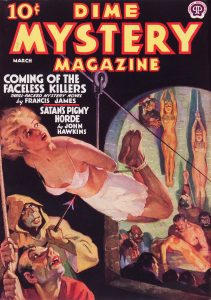 Garyn G. Roberts has written extensively about the pulps, both professionally and as a fan. He has edited or co-edited some of the best collections from the pulps including A Cent a Story: The Best from Ten Detective Aces, More Tales of the Defective Detective in the Pulps, The Compleat Adventures of the Moon Man, The Magical Mysteries of Don Diavolo, and The Compleat Great Merlini Saga. His anthology, The Prentice Hall Anthology of Science Fiction and Fantasy, a college-level textbook, is notable for the attention paid to the pulp magazines. Additionally, Garyn has helped other researchers with various pulp-related projects and often serves as a presenter and panelist at conventions. In 2013, Garyn received the Munsey Award, recognizing his efforts to keep the pulps alive for this and future generations.
Garyn G. Roberts has written extensively about the pulps, both professionally and as a fan. He has edited or co-edited some of the best collections from the pulps including A Cent a Story: The Best from Ten Detective Aces, More Tales of the Defective Detective in the Pulps, The Compleat Adventures of the Moon Man, The Magical Mysteries of Don Diavolo, and The Compleat Great Merlini Saga. His anthology, The Prentice Hall Anthology of Science Fiction and Fantasy, a college-level textbook, is notable for the attention paid to the pulp magazines. Additionally, Garyn has helped other researchers with various pulp-related projects and often serves as a presenter and panelist at conventions. In 2013, Garyn received the Munsey Award, recognizing his efforts to keep the pulps alive for this and future generations.
The general public is welcome to attend our evening programming events. To learn more about our schedule, please click the Programming button at the top of this page.
To enjoy our dealers’ room, join PulpFest 50 by clicking the Registration button at the top of this page. And don’t forget to book a room at the DoubleTree by Hilton Pittsburgh — Cranberry in Mars, Pennsylvania. They’re going fast!
PulpFest 50 will celebrate the ninetieth anniversary of Popular Publications’ “dime” line of pulp magazines from August 4 – 7. If not for its dime pulps, the company would never have enjoyed its tremendous success. Beginning with Dime Detective Magazine — launched in late 1931 — Popular’s “dime” line helped the publisher to become a powerhouse in the pulp magazine industry. Pictured above is the July 1932 Dime Detective Magazine, with cover art by William Reusswig.
About a year after the successful launch of Dime Detective, Popular launched two more “dime” pulps — Dime Western Magazine and Dime Mystery Book Magazine. Pictured above is the December 1932 Dime Mystery Book, featuring cover art by Delos Palmer.
Although Dime Western proved to be another success story, Dime Mystery Book Magazine suffered a less noble fate. In the fall of 1933, the magazine was reformatted at Dime Mystery Magazine, the first of the so-called “weird menace” or “shudder pulps.” Pictured above is the first issue of Dime Mystery Magazine, dated October 1933, with cover art by Walter M. Baumhofer. The artist painted the covers for the first 27 issues of the magazine. He was succeeded by Tom Lovell who painted the next seventeen covers. Pictured above is the March 1938 Dime Mystery Magazine, with cover by Lovell.
In 1941, Dime Mystery was again transformed. A few years later, it was combined with Ten Story Mystery. Pictured above is Dime Mystery Magazine for September 1946, with cover art by Gloria Stoll-Karn.
Our featured image is excerpted from Monroe Eisenberg’s cover for the September 1938 Dime Mystery Magazine.

